Rebecca’s Recipe of the Week: Gingery Green Noodles
This is another very fast dish of delicious slurpy noodles, spiked with basil, lime juice and sesame oil.
Ginger-Poached Noodles
Serves 2-3
Ingredients
4 cups vegetable broth (I used water with 2 tablespoons of white miso)
2 ounces fresh ginger, peeled and thinly sliced
8 ounces firm tofu or tempeh, cut into small cubes
approximately 2 cups of sprouting broccoli or shredded spring greens
4 ounces dried noodles of your choice (I used soba noodles)
1-2 tablespoons soya sauce
¼ cup fresh basil, shredded
¼ cup fresh mint, shredded
juice of half a lime
crushed red pepper flakes (I used part of a shredded Canalside chile)
toasted sesame oil
Preparation
Place the broth and ginger in a large saucepan and bring to a boil. Lower the heat, and simmer gently for ten minutes or so. Meanwhile, bring some water to the boil to cook the noodles.
Cook the noodles in the boiling water until they are tender, drain them, and set them aside.
After the broth has simmered for ten minutes add the and tofu or tempeh and the greens. Return to a boil, and then turn the heat back down to a simmer and cook for 5-8 minutes, or until the greens are tender.
Add the drained pasta to the broth and heat for a few more minutes, stirring regularly. Stir in the soya sauce, basil, mint, and lime juice. Before serving, if you have the energy you can fish out the slices of ginger, which are perfectly edible but a bit chewy.
Serve in bowls with a few pinches of crushed red pepper flakes, and a drizzle of sesame oil, to taste.
Recipe adapted from 101 Cookbooks.
Erica’s Recipe of the Week: Sweet, rich and sour Indian vegetable stew
Thanks to Erica Moody for suggesting this recipe from Meera Sodha’s column in last week’s Guardian Food.
Meera says: There might seem to be a lot of chillies in this, but it’s not a hot dish, because the natural sweetness of the squash and sweetcorn, combined with the rich coconut milk and spiky lime, balance things out. Fresh curry leaves are now sold in most major supermarkets.
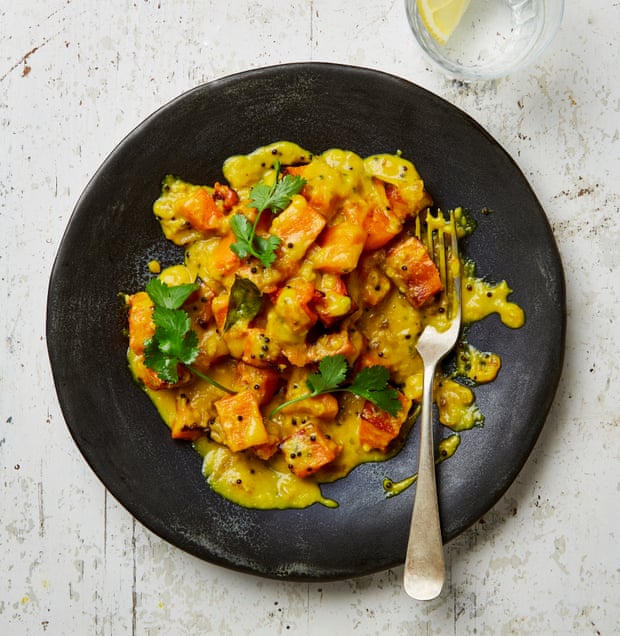
Butternut squash and sweetcorn erriseri
Prep 10 min
Cook 45 min
Serves 4
Ingredients:
1kg squash, washed
Sunflower oil
Fine sea salt
1 x 340g tin sweetcorn, drained
2 tsp black mustard seeds
12 curry leaves
1 large onion, peeled and finely chopped
4 garlic cloves, peeled and minced
3 green finger chillies, finely chopped
2 tsp turmeric
1 x 400ml tin coconut milk
2 tbsp fresh lemon juice (ie, from 1 lemon)
Coriander leaves, to garnish
Method:
Cut the squash in half (no need to peel), scoop out and discard the seeds, then cut it into 2cm cubes. Heat the oven to 200C (180C fan)/gas 6. Tip the squash pieces on to an oven tray, pour over two tablespoons of oil and a good sprinkling of salt, and toss to coat. Bake for 25-30 minutes, until the squash chunks are tender and their edges caramelised.
Add two tablespoons of water to the drained sweetcorn kernels and blend to a smooth paste (I use a stick blender).
In a large frying pan, heat two tablespoons of oil and, when hot, add the mustard seeds and curry leaves, and leave them to crackle and pop for a minute. Now add the onion and cook, stirring occasionally, for about 10 minutes, until translucent and turning golden, then add the garlic and chillies, and cook for two minutes. Stir in the sweetcorn paste, turmeric and a teaspoon and a half of salt, cook for a minute, then add the coconut milk (keep the tin) and whisk so everything is combined and the curry sauce is a vibrant yellow.
Half-fill the coconut milk tin with water and add to the pot to loosen the curry – you may need a little more or less water than this, depending on the thickness of your coconut milk – bring to a boil and simmer for five minutes, until it starts to thicken. Stir in the roast squash and lemon juice, and check the seasoning. Garnish with coriander and serve immediately.
Adapted from Guardian Food, 20th March 2020
Rebecca’s Recipe of the Week: Coconut, Potatoes, Beans
Meera Sodha’s East is excellent! Here is a gentle coconut-milk curry called an ‘istoo’, which is apparently derived from the English word ‘stew’. She recommends serving with aubergine pickle, and rice or an Indian flatbread. Some fried aubergine slices also go well.
Potato and Green Bean Istoo
Serves 2-3
Ingredients
2 tablespoons rapeseed oil
10 curry leaves
4cm cinnamon stick, broken in 2
1 medium onion (or 2 small onions), sliced
2cm piece of fresh ginger, peeled and grated
4 cloves of garlic, peeled and grated
1 green chile, slit in 2
650g small potatoes, halved
1 teaspoon each salt and pepper
1 400ml tin of coconut milk
250g green beans, topped and tailed
Preparation
In a casserole dish for which you have a lid, heat the oil on medium heat. Once it is hot add the curry leaves, cinnamon stick and onion. Reduce head to low and cook for 10 minutes, until the onion is soft but not brown. Add the ginger, garlic and chile, and cook for another 2-3 minutes.
Add the potatoes, salt and pepper and stir in the coconut milk. Then swill out the tin with about 100ml of water and add that to the pan as well. The potatoes should be just covered, so add more water if need be. Bring to a boil, and then reduce to a simmer and cook for 10-15 minutes, or until the potatoes are tender.
Add the beans, cover, and simmer for another 5 to 6 minutes, or until the beans are tender. Now it’s ready!
Recipe adapted from Meera Sodha, East (2019).
Rob’s Recipe of the Week: Sunny sweetcorn noodles
I wasn’t quite sure what to suggest this week and was resigned to the oven chips recipe I’ve been holding in reserve, until I spotted this noodle dish. It’s quite different to what I would normally cook and I’m excited to give it a try!
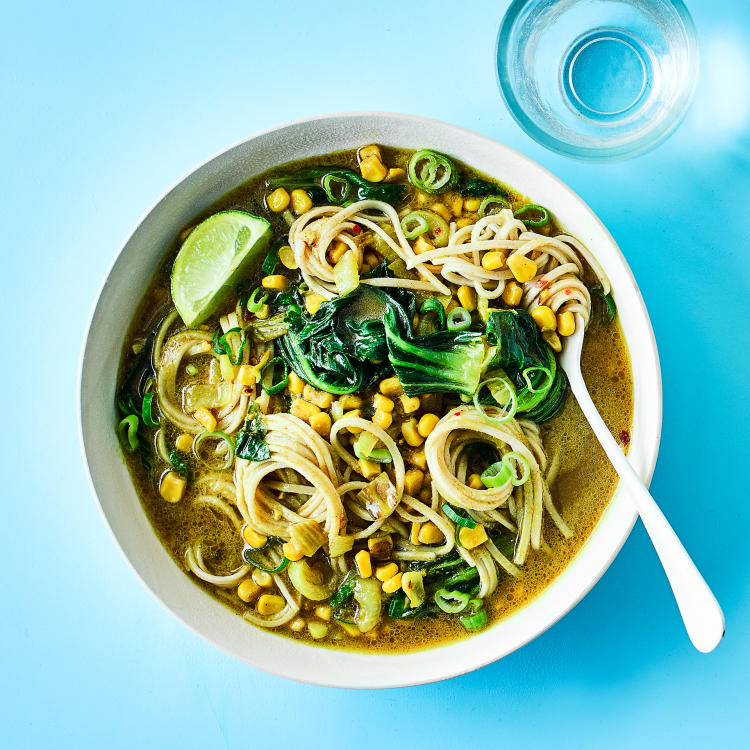
Sunny sweetcorn noodles
Ingredients:
- Chilli flakes (I’ve still got some Canalside dried chillies to get through!)
- coconut cream or coconut milk (add less water if not using cream)
- 2 garlic cloves
- 2 tbsp thai green curry paste
- lime or lime juice
- 250g pak choi
- 35ml soy sauce
- 1 spring onion (optional garnish)
- 1tsp turmeric
- sweetcorn
- noodles (2 nests)
- 1 veg stock cube
Method:
Peel and thinly slice garlic and boil the kettle
Add sweetcorn on the cob to large pan of water and boil for 10 minutes
Cut pak choi in half to separate stems from leaves. Leave leaves whole and cut stems into bitesize pieces
In a large pan (preferably with a lid) heat some oil (high heat) then add turmeric and cook for 30 seconds.
Add sliced garlic and curry paste and cook for 2 minutes
Use this time to put noodles on to boil for about 5 minutes or according to instructions
Add pak choi stems and a large pinch of salt and cook for ~3 minutes with lid on until stems are tender
If using coconut cream, mix this with stock and 350ml of hot water. If coconut milk, add this and stock direct to pan.
Add cream mix / cocunut milk and stock to the pan of veg, along with the chilli flakes and soy sauce
Set to low heat whilst you take out the sweetcorn and use a knife to separate the corn from the cob
Add sweetcorn and pak choi leaves to the pan, add water to achieve your preferred consistency and boil on low heat until leaves have wilted.
Bowl up the noodles and veg soup, adding lime juice and chopped spring onions on top if you’ve got them
Adapted from https://www.gousto.co.uk/cookbook/vegetarian-recipes/sunny-sweetcorn-noodles
Rebecca’s Recipe of the Week: In Praise of Potatoes
In honour of the recent potato harvest, here is a splendid Nepalese potato salad from the Idaho Potato Commission. The Andean potato probably reached Nepal some time in the 1700s; it is now become a staple. In 2017 the country harvested 2,691,037 tonnes. This salad combines potatoes, fresh coriander, and spiced yoghurt to create a complex and satisfying dish. Eat with shredded carrot salad, and perhaps some flatbread.
The Potato Commission thinks this will serve 4 people, but we ate most of it in one sitting. ‘This is scrum’ declared Matt.
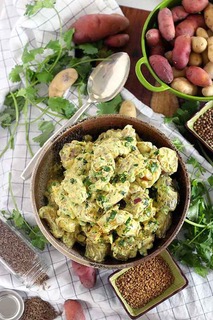
Chukauni: Nepalese Potato Salad
Ingredients
700g potatoes
1 cup frozen peas
½ cup red onion, finely chopped
½ cup fresh coriander, finely chopped
1 cup yoghurt, plus additional yoghurt, to serve
1 teaspoon salt
2 tablespoons rapeseed or vegetable oil
1 tablespoon coriander seeds
1 teaspoon cumin seeds
1 teaspoon fenugreek seeds
½ Canalside chile, finely chopped, seeds removed if desired
½ teaspoon turmeric
Preparation
Place the potatoes in a pot of cold water and bring slowly to the boil. Cook over very low heat until tender. Fish out the potatoes, drain, and set aside, keeping the water in the pan. Turn off the heat and then tip the peas into the hot water. Leave them there for 60 seconds and then drain them as well.
Once the potatoes are cool enough to handle, cut them into 2cm cubes.
Combine the peas, red onion, coriander, yoghurt and salt in a serving bowl. Stir and add the potatoes.
Heat the oil in a frying pan over medium-high heat. Once it is hot add the coriander, cumin and fenugreek seeds. Let sizzle for about 30 seconds, until they turn reddish brown. Remove from the heat and add the chile and turmeric. Toss so that the oil turns a sunny yellow.
Pour the oil–but not the seeds—over the salad. Keep as many seeds as possible back in the pan. Mix the oil into the salad and taste.
Now you have a choice: if the salad strikes you as perfectly delicious as it is, then you’re done. Serve and enjoy, with additional yoghurt on the side if you like.
If you think it needs a little more oomph, then scrape the seeds into a mortar and pestle and grind them until they’re a coarse powder. Sprinkle some or all of this into the salad, tasting as you go along. Once you’re pleased with the result, serve and enjoy.
Recipe adapted from the Idaho Potato Commission.
Rebecca’s Recipe of the Week: Fried Aubergine Slices
Meltingly tender circles of fried aubergine make an excellent nibble, and a spicy accompaniment to any meal. The recipe below gives the amount for one small Canalside aubergine, but is easily scaled up. I’ve never had any left over, but Madhur Jaffrey says they’re good warmed up the next day.
Fried Aubergine Slices
Ingredients
1 Canalside aubergine
1 teaspoon salt
½ teaspoon turmeric
¼ teaspoon cayenne pepper, or ½ a Canalside dried chile (seeds removed if you prefer), chopped fine
Freshly-ground black pepper
Vegetable oil, for shallow frying
½ lemon wedge, to serve
Preparation
Cut the aubergine into slices about 1cm thick.
Mix together the salt, turmeric, cayenne or chile and black pepper in bowl.
Toss the aubergine with the mixed spices.
Heat about ½cm oil in a frying pan over medium heat. When it’s hot put in as many aubergine slices as will fit comfortably in a single layer. Don’t crowd the pan or they won’t fry properly. Fry until reddish-brown on the bottom. Flip and fry the other side.
Remove them as they are done, onto some kitchen paper or a cloth, and fry the remainder. Add more oil if necessary.
Serve with a squeeze of lemon.
Recipe adapted from Madhur Jaffrey, Indian Cooking (2002).
Rebecca’s Recipe of the Week: Buckwheat dosa with coconut chutney and greens
Rebecca’s Recipe of the Week: Buckwheat dosa with coconut chutney and greens
Another easy and delicious recipe from Meera Sodha. She writes: ‘This dish consists of three separate elements: the dosa batter, the coconut chutney and the vegetable filling. . . The key to success is to make [the dosas] in a nonstick pan on a very high heat – it needs to be very hot indeed – and make sure you leave them to crisp up properly before even thinking about flipping them with a spatula. The first pancake will inevitably fail – such is the universal law of pancakes – so make it a small one, so as not to waste too much batter’.
Buckwheat dosa with coconut chutney and greens
Serves 3
Ingredients
100g desiccated coconut
Salt
180g buckwheat flour
6 tbsp oil, plus extra for brushing
12 fresh curry leaves
1 tablespoon cumin seeds
1 tablespoon black mustard seeds
3 garlic cloves, peeled and minced
2cm ginger, peeled and grated
1-2 green chillies, finely chopped (or to taste)
400g chard or spinach, leaves shredded, tough stalks roughly chopped
200g frozen peas
Preparation
Put the desiccated coconut in a heatproof bowl with a third of a teaspoon of salt, cover with 275ml boiling water and leave to soak for at least 30 minutes.
Meanwhile, put the buckwheat flour in another bowl with half a teaspoon of salt. Slowly pour in 450ml water, mix to a thin batter, then set aside.
Put the oil in a nonstick frying pan and get it really hot, then add the curry leaves, cumin, mustard seeds, garlic, ginger and chillies, and fry for two to three minutes, until the garlic turns a pale gold. Carefully tip into a jug to cool. Keep the pan for later.
When the spiced oil has cooled, stir two tablespoons into the coconut mix, and another two tablespoons into the buckwheat batter. Tip the coconut into a blender and blitz until really smooth (add a little more water, if need be).
Reheat the frying pan over a high heat and, when hot, add the rest of the spiced oil, followed by the chard or spinach stalks. Fry, stirring, for three minutes, then add the leaves and cook until wilted. Throw in the peas, cook for a couple of minutes, until everything is nice and hot, then stir through a couple of tablespoons of the coconut chutney. Scrape out into a serving dish, wipe the pan clean with kitchen paper and put back on the heat.
Once the pan is really hot, brush the surface with a fine layer of oil. Add a small ladleful of batter and swirl it into a thin layer – a few gaps and bubbles are fine, because they can help the dosa get crisp. Cook the dosa for two minutes, until the edges are visibly crisp and browning, then gently lever up with a spatula, flip and cook for a further two minutes on the other side, before turning it out on to a plate. Repeat with the remaining batter, oiling the pan between each dosa.
Stuff the dosas with the greens and serve with the remaining chutney on the side.
Recipe adapted from Meera Sodha, The Guardian, 13 July 2019.
Rob’s Recipe of the Week: Dinner on the run
I went to a very interesting sports food recovery workshop with a nutritionist called “whole food warrior” whilst at a running festival earlier in the summer. This is one of her recipes which should be pretty quick and simple, enjoy!
Chickpea, green bean & spinach curry (15-minute recipe)
Ingredients (feeds 2)
For the curry paste:
A handful of fresh coriander, stalks & leaves (10-15g)
1/2 green pepper (75g), roughly chopped
1 red chilli, roughly chopped
1/2 thumb size piece of ginger (15g), peeled and roughly chopped
1 small onion (55g), peeled and roughly chopped
1 turmeric root or 1/4 teaspoon of turmeric powder
1/2 lemon, peeled (you are using the actual lemon here, not the rind)
1 teaspoon of cumin seeds
1/2 teaspoon of cinnamon
sea salt and freshly ground black pepper
Other ingredients:
150g of dwarf beans or green beans
1 tin of chickpeas
1/2 a tin of chopped tomatoes (200ml)
1/2 a tin of coconut milk (200ml)
4 large handfuls of spinach (approximately 120g)
Method:
Put all of the curry paste ingredients in a blender, season with a pinch of sea salt and some freshly ground black pepper and blend until smooth. Add a splash of water to make the bending easier if needed.
Put a frying pan on a medium high heat. Tip in the curry paste and cook until it thickens to a paste, approximately 5 minutes.
Pour in the chopped tomatoes and coconut milk, stir well, season with a little bit more sea salt and black pepper.
Add the green beans and cook for 5 minutes.
Tip in the chickpeas and spinach and cook for a further 5 minutes until the sauce has thickened.
Check the taste and season with more black pepper and sea salt if needed.
To serve, simply divide the curry between two large bowls. Sprinkle on some extra coriander leaves if desired.
Taken from: https://wholefoodwarrior.co.uk/blog/quickcurry
16th aug
Rebecca’s Recipe of the Week: Green Beans, Tomatoes and Saffron
Serve this lovely blend of tomatoes, beans and saffron-scented onions as a side dish, or alongside some polenta topped with a poached egg. It’s also tasty accompanying plain white fish.
Fagiolini in umido all zafferano
Serves 4 as a side dish.
Ingredients
10 medium tomatoes
60ml olive oil
2 medium onions, peeled and thinly sliced
1 small pinch of saffron
650g green beans, topped and tailed
Preparation
Bring a medium pot of water to the boil. Prepare a bowl of ice water.
Score the bottom of each tomato with a X, using a sharp knife, and remove the core. Drop the tomatoes into the boiling water a few at a time, and cook for about 30 seconds each, until the skin starts to loosen. Remove with a slotted spoon and drop into the bowl of ice water. Don’t discard the hot water: you’ll use it to cook the beans.
Fish each tomato out of the ice water and slip off the skin. Dice into small cubes.
Put the olive oil and sliced onions into a saucepan over very low heat. Add a pinch of salt and the saffron. Cook gently for 20-25 minutes, or until the onions are soft and translucent. Stir occasionally and make sure they don’t catch or burn.
Add the diced tomatoes and cook for 10 more minutes. Season with salt.
Bring the tomato water to a boil, salt, and cook the beans for 6 minutes, or until tender. Drain the beans and add to the onion-saffron-tomatoes. Simmer for 3 more minutes over low heat and serve.
Recipe adapted from Christopher Boswell and Elena Goldblatt, Verdure: Vegetable Recipes from the American Academy in Rome (2014).
Rebecca’s Recipe of the Week: A Warm Salad of French Beans with Gingery Noodles
Warm Japanese noodles and bright green vegetables, tossed with a sharp, gingery dressing make a quick and delicious dinner. The whole thing comes together in under 25 minutes. I think you could add some toasted, chopped peanuts to the top, as well.
The dressing is also very good tossed onto shredded cabbage and kohlrabi, for a punchy slaw.
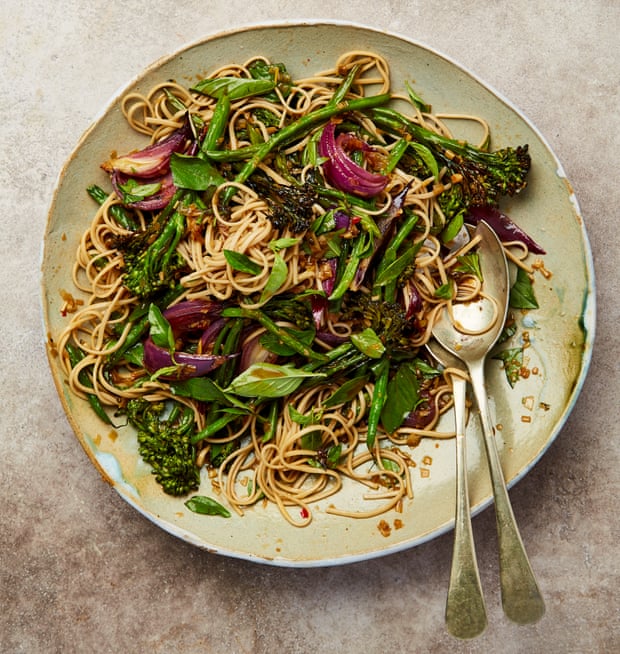
Charred broccoli and bean soba noodle salad
Serves 2
Ingredients
For the salad
450g French beans and/or broccoli (any combination)
2 red onions, peeled and cut into 8 wedges
2 tbsp rapeseed oil
¼ tsp salt
200g soba noodles, or a mixture of soba and udon noodles
¼ cup Thai basil and/or mint leaves, roughly chopped
For the dressing
4 spring onions (use the whole thing), finely chopped
4cm piece fresh ginger, peeled and finely grated
3 tbsp toasted sesame oil
3 tbsp rice wine vinegar (Meera Sodha specifies black Chingkiang vinegar)
4 tbsp light soy sauce
1 tbsp brown rice (or maple) syrup
1 dried red chilli, finely chopped, or de-seeded and then left whole if you’d like the option of removing it later
Preparation
Pre-heat the oven to 220C.
Trim the broccoli into long, slender strips. You can include the green leaves if you like, as well. Top and tail the beans.
Place the broccoli and/or beans and onion wedges on a baking tray. Drizzle over the oil and sprinkle with salt. Mix with your hands, and roast for 10-20 minutes, until they are a bit charred and the leaves have become crispy.
Bring a large pan of water to a boil, then cook the noodles according to packet instructions. Drain and rinse under cold water, then leave to one side to drain.
For the dressing, put all the ingredients in a small saucepan, bring to a boil, then take off the heat and put to one side.
When the vegetables have cooked, tip them into a serving bowl, add the drained noodles and dressing, and toss. Toss in the herbs, and serve while the vegetables are still a little warm.
Recipe adapted from Meera Sodha, The Guardian, 22 June 2019.
Rebecca’s Recipe of the Week: Spicy Coconut Cauliflower
Cumin-scented cauliflower, yellow from turmeric, cooks with Canalside chile and a subtle coconut-poppy seed glaze. The result is spicy, satisfying and beautiful. Eat it topped with toasted almonds, fresh coriander, yoghurt and a squeeze of lime. Yotam recommends serving with flatbread, but it’s pretty delicious just on its own.
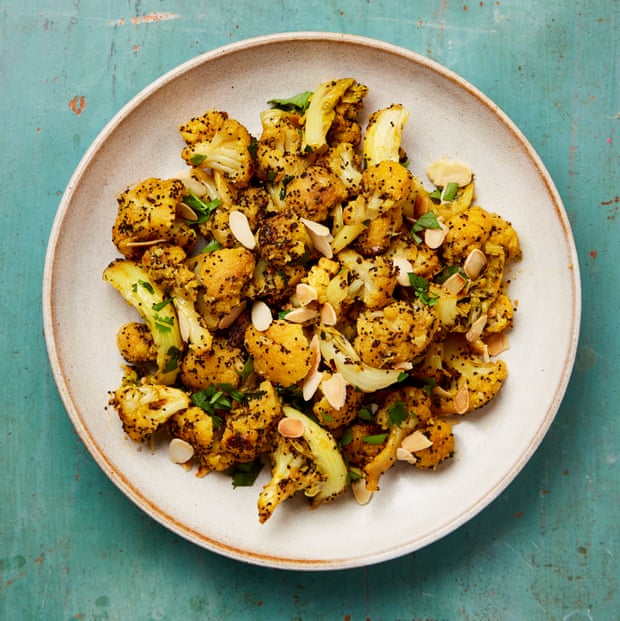
Poppy-Seed Cauliflower with Coconut
Serves 2
Ingredients
40g poppy seeds
60ml sunflower oil
½ – 1 Canalside dried red chile, de-seeded if desired, and shredded
1 teaspoon turmeric
1 teaspoon cumin seeds
2 garlic cloves, peeled and sliced fine
1 large cauliflower and leaves, broken into 4cm-sized florets, leaves shredded
150ml coconut milk (approx.)
To serve
1 handful fresh coriander, shredded
1 small handful flaked almonds, lightly toasted in a dry pan
plain yoghurt
1 lime, halved
Preparation
Put the poppy seeds in a small bowl. Pour over just enough boiling water to cover them. Leave them for half an hour, and then whiz them in a blender or food processor, or crush them in a mortar and pestle, so that they begin to break up a bit. Set aside.
Heat the oil over medium-high heat in a large sauté pan for which you have a lid. When it is hot add the chile, turmeric, cumin and garlic. Turn the heat to medium and sauté for 4 minutes, stirring often, until the garlic starts to brown and the mixture gives off a nice smell.
Add the cauliflower leaves and florets and toss with the spices. Stir for 2 minutes, until the cauliflower has turned an attractive yellow.
Add the coconut milk and the poppy seeds. Add enough coconut milk to make a little sauce, but not so much that it is soupy. Turn the heat down a little and cover. Cook for 4 more minutes, until the cauliflower has begun to soften.
Uncover and turn the heat up to medium-high. Cook for 8 more minutes, stirring regularly, until the cauliflower is tender and has begun to caramelise and the liquid has evaporated.
Serve topped with fresh coriander, toasted almonds, yoghurt and a squeeze of lime.
Recipe adapted from Yotam Ottolenghi, The Guardian, 16 Feb. 2019.